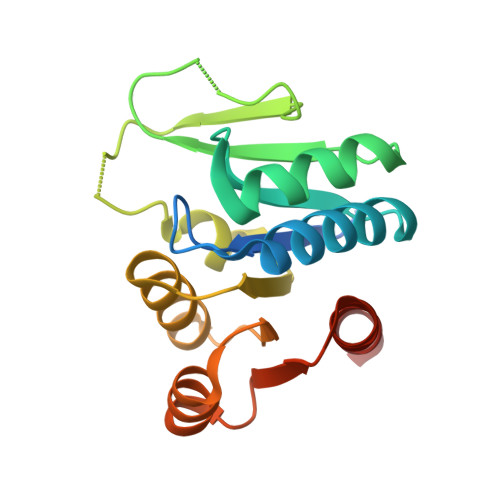Function and Structure of the Molybdenum Cofactor Carrier Protein from Chlamydomonas Reinhardtii.
Fischer, K., Llamas, A., Tejada-Jimenez, M., Schrader, N., Kuper, J., Ataya, F.S., Galvan, A., Mendel, R.R., Fernandez, E., Schwarz, G.(2006) J Biol Chem 281: 30186
- PubMed: 16873364
- DOI: https://doi.org/10.1074/jbc.M603919200
- Primary Citation of Related Structures:
2IZ5, 2IZ6, 2IZ7 - PubMed Abstract:
The molybdenum cofactor (Moco) forms the catalytic site in all eukaryotic molybdenum enzymes and is synthesized by a multistep biosynthetic pathway. The mechanism of transfer, storage, and insertion of Moco into the appropriate apo-enzyme is poorly understood. In Chlamydomonas reinhardtii, a Moco carrier protein (MCP) has been identified and characterized recently. Here we show biochemical evidence that MCP binds Moco as well as the tungstate-substituted form of the cofactor (Wco) with high affinity, whereas molybdopterin, the ultimate cofactor precursor, is not bound. This binding selectivity points to a specific metal-mediated interaction with MCP, which protects Moco and Wco from oxidation with t((1/2)) of 24 and 96 h, respectively. UV-visible spectroscopy showed defined absorption bands at 393, 470, and 570 nm pointing to ene-diothiolate and protein side-chain charge transfer bonds with molybdenum. We have determined the crystal structure of MCP at 1.6 Angstrom resolution using seleno-methionated and native protein. The monomer constitutes a Rossmann fold with two homodimers forming a symmetrical tetramer in solution. Based on conserved surface residues, charge distribution, shape, in silico docking studies, structural comparisons, and identification of an anionbinding site, a prominent surface depression was proposed as a Moco-binding site, which was confirmed by structure-guided mutagenesis coupled to substrate binding studies.
Organizational Affiliation:
Institute of Plant Biology, Technical University Braunschweig, 38106 Braunschweig, Germany.














